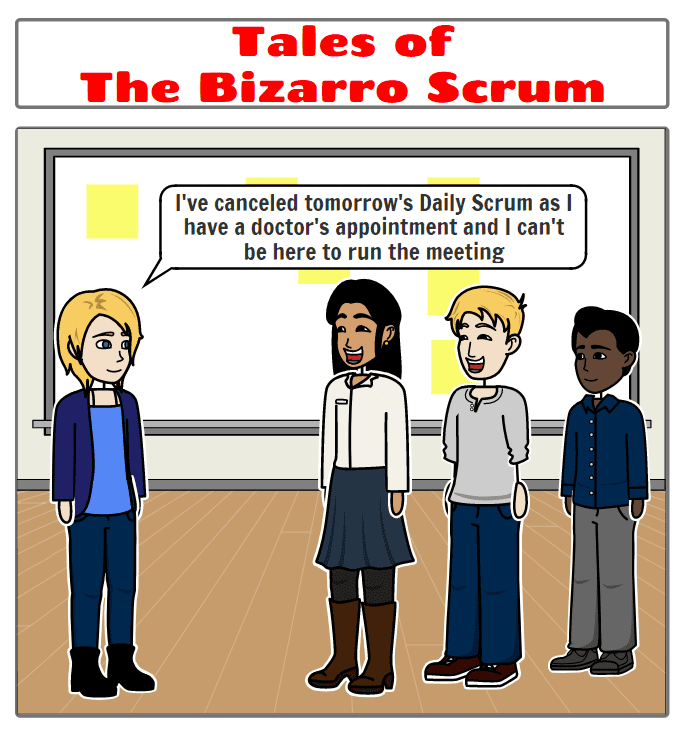Scrum Master: “Team, tomorrow’s daily Scrum has been canceled as I have a doctor appointment and I can’t be there to run the meeting.”
A statement like this indicates a misunderstanding of the purpose of the Daily Scrum, the role of the ScrumMaster as well as the importance of sticking to a cadence.
A common misconception is that the Daily Scrum is a status meeting with the Developers reporting status to the ScrumMaster, Product Owner, managers, or stakeholders. The Daily Scrum is a daily planning meeting for the team by the team. It is an important step in Scrum’s inspect and adapt cycles. This time it is about inspecting and adapting the Sprint Backlog and planning out the day. The Developers created the initial Sprint backlog at the beginning of the Sprint in the Sprint Planning meeting. Every day, the team gets together to coordinate and plan out their activities for that day and ensure they are making forward progress towards the Sprint goal and adjusting the Sprint Backlog accordingly.
Whether the ScrumMaster is there or not is immaterial. The key players in this event are the Developers. They are there to come up with the plan for the day and see if adjustments need to be made to meet the Sprint goal, ask for help, volunteer to help, etc.
If the ScrumMaster is there, then they are there to facilitate the discussion by keeping it focused on the Sprint goal, staying within the timebox, making any impediments transparent, and ensuring forward progress is being made. Alternatively, any team member can help with that.
Finally, sticking to a cadence simplifies scheduling. Having to keep shifting, canceling, and rescheduling events based on people’s availability adds an unnecessary extra layer of complexity. It is ok if someone cannot make it to an event every once in a while, especially with an event that occurs daily. They can always get caught up afterward if needed.
- Tales of the Bizarro Scrum
- Tales of the Bizarro Scrum – Developers and Deliverables
- Tales of the Bizarro Scrum – Are You Sure It’s Going to Take this Long?
- Tales of the Bizarro Scrum – The BAs are Holding Us Back!
- Tales of the Bizarro Scrum – Yes, We Are a Self-organizing Team
- Tales of the Bizarro Scrum – Assigning Points to Everything
- Tales of the Bizarro Scrum – Isn’t Scrum Just a Team Level Thing?
- Tales of the Bizarro Scrum – The Code Freeze
- Tales of the Bizarro Scrum – Refining the upcoming 8 Sprints?
- Tales of the Bizarro Scrum – Of Course We Are Agile!
- Tales of the Bizarro Scrum – I’m Responsible for Writing User Stories
- Tales of the Bizarro Scrum – Scrum Master Canceling the Daily Scrum
- Tales of the Bizarro Scrum – The Sprint was a Colossal Failure
- Tales of the Bizarro Scrum – When is Sprint Planning?
- Tales of the Bizarro Scrum – Canceling the Sprint Retrospective
- Tales of the Bizarro Scrum – Product Owner Missing Sprint Planning?
- Tales of the Bizarro Scrum – Extending the Sprint
- Tales of the Bizarro Scrum – I’m the Product Owner and Scrum Master
